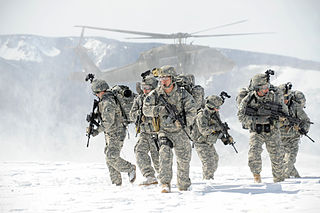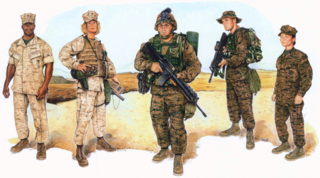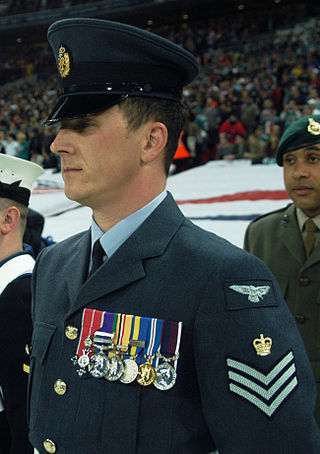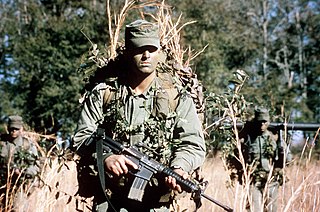
The Battle Dress Uniform (BDU) is a camouflaged combat uniform that was used by the United States Armed Forces as their standard combat uniform from the early 1980s to the mid-2000s. Since then, it has been replaced or supplanted in every branch of the U.S. Armed Forces.

The Army Combat Uniform (ACU) is the current combat uniform worn by the United States Army, U.S. Air Force, and U.S. Space Force. Within U.S. Air Force and U.S. Space Force, it is referred to as the OCP Uniform, rather than the Army Combat Uniform.

The M-1965 Field Jacket, named after the year it was introduced, is a popular field jacket initially designed for the United States Armed Forces under the MIL-C-43455 standard.

The Denison smock was a coverall jacket issued to Special Operations Executive (SOE) agents, the Parachute Regiment, the Glider Pilot Regiment, Air Landing Regiments, air observation post squadrons, Commando units, and other Commonwealth airborne units, to wear over their Battle Dress uniform during the Second World War. The garment was also issued as standard to the scout and sniper platoons of line infantry battalions.

Disruptive Pattern Camouflage Uniform (DPCU), also nicknamed Auscam, jelly bean camo, or hearts and bunnies is a five-colour military camouflage pattern used by the Australian Defence Force. Replacing the jungle greens used from WWII, it was developed and tested during the late 1970s and early 1980s. The uniform was trialled in 1987, with it being slowly introduced in late 1989, with the last production and discontinuation of the jungle greens being in late 1990. Jungle greens were last issued in late 1991 for Australian Regular Army, and late 1994 for Australian Army Reserve.
The uniforms of the Canadian Armed Forces are the official dress worn by members of Canada's military while on duty.

The Extended Cold Weather Clothing System is a protective clothing system developed in the 1980s by the United States Army Natick Soldier Research, Development and Engineering Center, Natick, Massachusetts. The first generation ECWCS consisted of parka and trousers plus 20 other individual clothing, handwear, headwear and footwear items which are used in various combinations to meet the cold weather environmental requirements of the US military. The Extended Climate Warfighter Clothing System, or Gen III ECWCS, is designed to maintain adequate environmental protection in temperatures ranging between −60 and +40 °F.

The Marine Corps Combat Utility Uniform (MCCUU) is the current battledress uniform of the United States Marine Corps. It is also worn by Navy personnel assigned to Marine Corps units.

The Army Combat Shirt (ACS) is a flame-resistant shirt developed and used by the United States Army as a supplementary addition to the Army Combat Uniform. The ACS is a stand-alone shirt designed specifically for use with Improved Outer Tactical Vest armor in warm and hot weather instead of the blouse. It is intended to greatly increase user comfort through the use of lightweight, moisture-wicking, and breathable fabrics. The ACS was created in conjunction with the USMC's Flame Resistant Organizational Gear (FROG). The ACS, in conjunction with the Fire Resistant ACU (FRACU) trousers, provides head-to-toe protection against burns.

The Royal Air Force uniform is the standardised military dress worn by members of the Royal Air Force. The predominant colours of Royal Air Force uniforms are blue-grey and Wedgwood blue. Many Commonwealth air forces' uniforms are also based on the RAF pattern, but with nationality shoulder flashes. The Royal Air Force Air Cadets wear similar uniforms.

The uniforms of the United States Air Force are the standardized military uniforms worn by members of the United States Air Force to distinguish themselves from the other services.

Type 07 is a group of military uniforms used by all branches of the People's Liberation Army (PLA) of the People's Republic of China (PRC) and the paramilitary Chinese People's Armed Police Force. Introduced in 2007, the Type 07 uniforms replaced the Type 87 service uniforms used by regular units and the Type 97 Service Dress uniforms of the People's Liberation Army Hong Kong Garrison and the People's Liberation Army Macau Garrison. The Type 07 uniforms were first seen in late June 2007 during a celebration ceremony for the 10th anniversary of the Transfer of sovereignty over Hong Kong.

A patrol hat, also known as a field cap, is a soft kepi constructed similarly to a baseball cap, with a stiff, rounded visor but featuring a flat top, worn by military personnel of some countries in the field when a combat helmet is not required.

The following is a general overview of the Heer main uniforms, used by the German Army prior to and during World War II.

The OG-107 was the basic work utility uniform (fatigues) of all branches of the United States Armed Forces from 1952 until its discontinuation in 1989. The designation came from the U.S. Army's coloring code "Olive Green 107", which was the shade of dark green used on the original cotton version of the uniform. The OG-107 was superseded by the Battle Dress Uniform (BDU) throughout the 1980s, and was also used by several other countries, including ones that received military aid from the United States.

The Luftwaffe was the air force of Nazi Germany prior to and during World War II. Luftwaffe styles of uniform and rank insignia had many unique features between 1935 and 1945. By Hitler's decision on February 26, 1935, the Luftwaffe was to be officially the third branch of the Wehrmacht as of March 1, 1935. The new Luftwaffe was faced with the problem of uniforms, as they wanted a uniform distinct from those of the other two branches of the Wehrmacht and also wanted a clear differentiation in dress of military and civilian flyers.

Operational Camouflage Pattern (OCP), originally codenamed Scorpion W2, is a military camouflage pattern adopted in 2015 by the United States Army for use as the U.S. Army's main camouflage pattern on the Army Combat Uniform (ACU). This pattern officially replaced the U.S. Army's previous Universal Camouflage Pattern (UCP) as the official combat uniform pattern for most U.S. soldiers at the end of September 2019. The pattern also superseded the closely related MultiCam, a pattern previously used for troops deploying to Afghanistan.
The Navy Working Uniform (NWU) is a series of military uniforms that are currently used by the United States Navy for wear by its members. The NWU is a "working" uniform, which means that it is made to a more durable and utilitarian standard, thus being worn in lieu of more formal uniforms that might get unduly damaged or dirtied in the process of normal military duties.

The uniforms of the United States Space Force are the standardized military uniforms worn by U.S. Space Force personnel, known as guardians.

EMR ; or Universal Camouflage Colourway in English, is a military camouflage pattern in use by the Russian Armed Forces. It is sometimes referred to by the unofficial nicknames RUSPAT, Tetris, Tsifra and Digital Flora. EMR camouflage is the standard camouflage pattern of the Russian Military's VKBO All-Season Uniform.


















